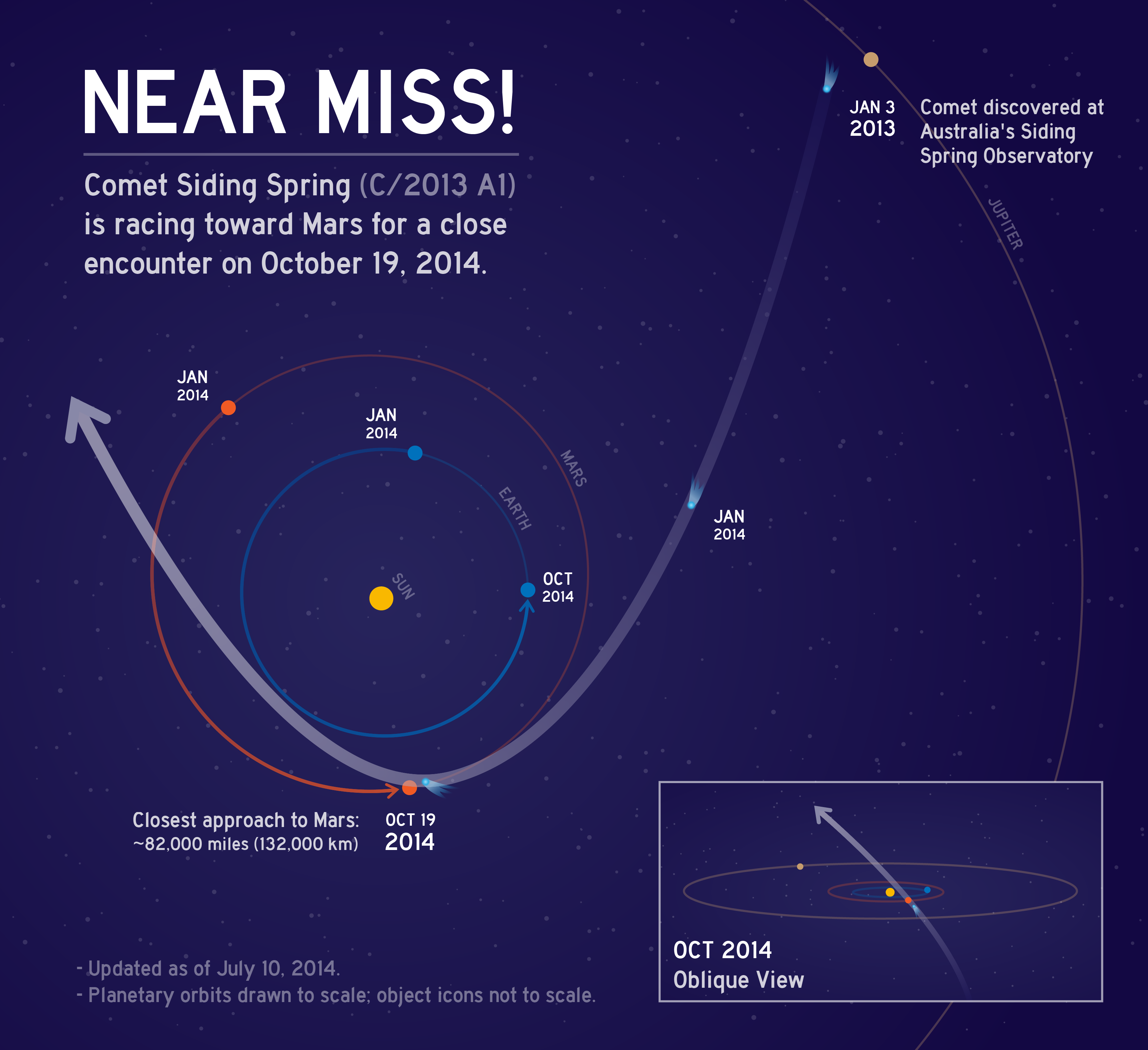
Earth’s invasion fleet at Mars is about to experience an unprecedented close encounter with a new cometary visitor this fall, and NASA is implementing a multi-pronged strategy that’s simultaneously aimed at reaping an unexpected scientific bonanza while also protecting its priceless orbiting armada from “Gravity” like destruction from a trail of hurtling space debris.
Comet C/2013 A1 Siding Spring is swinging around the Sun and heading toward an extremely close flyby with the Red Planet on Oct. 19, 2014. See the flyby graphics and animation above and below.
The comet’s nucleus will fly by Mars at a distance of only about 82,000 miles (132,000 kilometers) at 2:28 p.m. ET (18:28 GMT). That’s barely one-third the distance from the Earth to the Moon.
And as if that wasn’t exciting enough, the ultra close flyby of Comet Siding Spring will be about 16 times closer to Mars than the closest ever recorded Earth approach by a comet.
When the now-defunct comet Lexell sped by Earth two and a half centuries ago, on July 1, 1770, it flew to within 1.4 million miles (2.3 million km) or about six times farther away than the Moon.
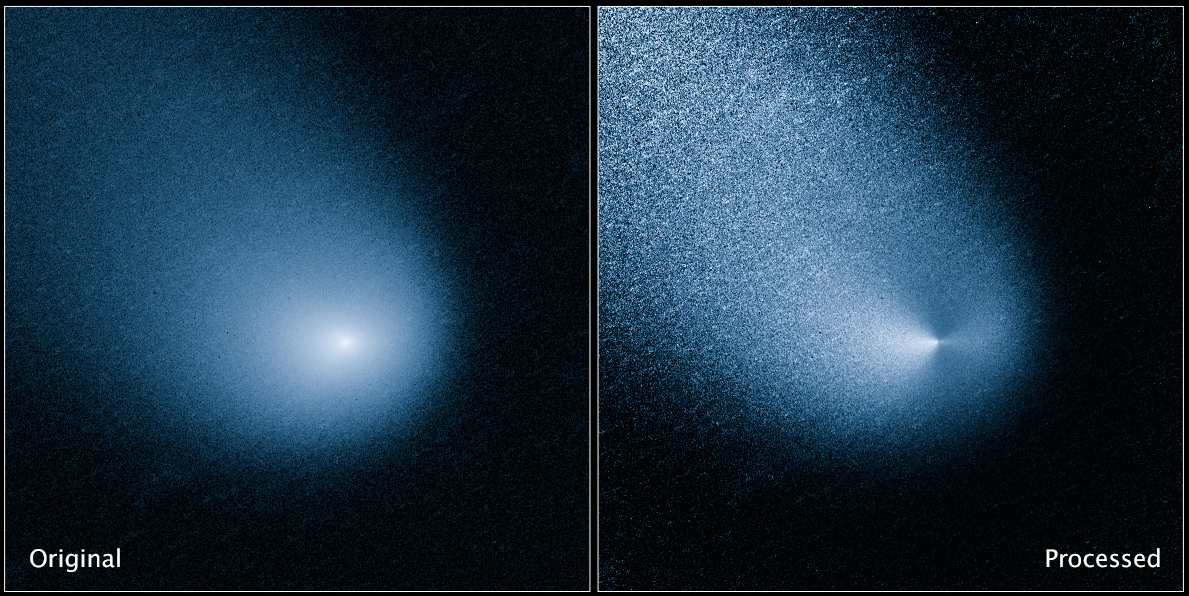
The images above show–before and after filtering–comet C/2013 A1, also known as Siding Spring, as captured by Wide Field Camera 3 on NASA’s Hubble Space Telescope. Image Credit: NASA, ESA, and J.-Y. Li (Planetary Science Institute)
October’s swingby also marks the comet’s first passage through the inner Solar System on its millions-year orbital journey from the Oort cloud.
So just imagine the breathtaking celestial view if you were circling over Mars or driving across its surface! And the thrill of investigating pristine, primordial material!
But at the distance of only 82,000 miles (132,000 kilometers), the comet is close enough that gas and dust in the outermost reaches of the comet’s atmosphere, or coma, will impinge the Martian atmosphere of Mars—and maybe impact spacecraft.
And Siding Spring will be spewing out material at a velocity of about 35 miles (56 kilometers) per second, relative to Mars and Mars-orbiting spacecraft.
NASA says that when Siding Spring flies by Mars, “even the smallest particle — estimated to be about one-fiftieth of an inch (half a millimeter) across — could cause significant damage to a spacecraft.”
And precisely because of the potential for damage from a shower of hurtling debris, NASA is repositioning its two orbiters currently operating at Mars as well as a third one arriving less than one month before the comet’s swingby. Engineers will reposition all the orbiters on the opposite side of the Red Planet when the comet is most likely to pass by.
Therefore, NASA has to balance the magnificent opportunities for science with the deadly potential for utter destruction.
NASA’s currently operating orbiter fleet comprises Mars Odyssey (MO), launched in 2001, and the Mars Reconnaissance Orbiter (MRO), launched in 2005.
NASA’s next and final planned Mars orbiter, the Mars Atmosphere and Volatile EvolutioN (MAVEN) spacecraft, is scheduled to arrive in the vicinity on Sept. 21.
MO and MRO currently provide the essential communications link for transmitting virtually all of the imagery and measurements from NASA’s Curiosity and Opportunity rover expeditions on Mars’ surface today. MAVEN will assist.
In a nutshell: “No Mars Orbiters, No Mars Images.”
So MO and MRO are the indispensable science relay links for NASA’s current surface assets, as well as the next vehicles arriving in coming years: the 2016 InSight lander and the 2020 Curiosity-like Rover.
The period of greatest spacecraft risk starts about 90 minutes after closest approach and lasts about 20 minutes, when Mars will come closest to the center of the widening dust trail from the comet’s nucleus.
“Three expert teams have modeled this comet for NASA and provided forecasts for its flyby of Mars,” explained Rich Zurek, chief scientist for the Mars Exploration Program at NASA’s Jet Propulsion Laboratory (JPL) in Pasadena, Calif., in a statement.
“The hazard is not an impact of the comet nucleus, but the trail of debris coming from it. Using constraints provided by Earth-based observations, the modeling results indicate that the hazard is not as great as first anticipated. Mars will be right at the edge of the debris cloud, so it might encounter some of the particles — or it might not.”
MRO already executed its first orbit-adjustment protective maneuver on July 2. Another is planned for Aug. 27. MO will implement an adjust burn on Aug. 5. The MAVEN team plans to conduct a “precautionary maneuver on Oct. 9, prior to the start of the mission’s main science phase in early November,” says NASA.
No precautions are necessary for Curiosity and Opportunity due to the shielding effects of Mars’ thin atmosphere.
All three orbiters and the two surface rovers will train their arrays of instruments and cameras to study the nucleus, coma surrounding the nucleus, and tail of Siding Spring in the days just before and after the flyby to take advantage of this unparalleled bonus opportunity.
The spacecraft will also investigate possible effects on the Martian atmosphere.
MAVEN is particularly well-suited in this regard since its specific mission is to conduct the first science study of Mars’ upper atmosphere.
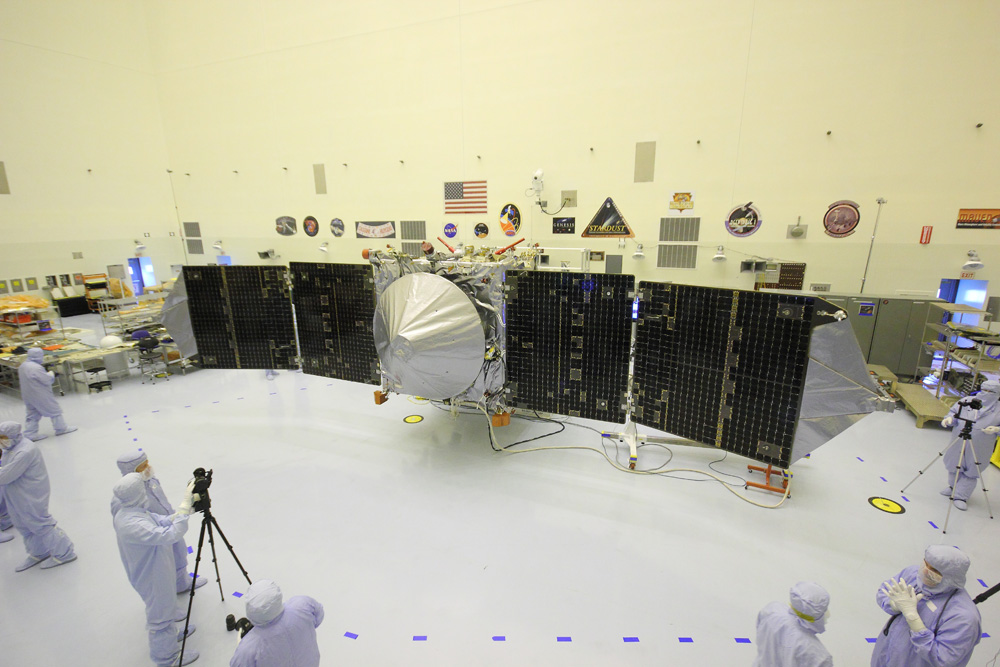
“It will study gases coming off the comet’s nucleus into its coma as it is warmed by the sun. MAVEN also will look for effects the comet flyby may have on the planet’s upper atmosphere and observe the comet as it travels through the solar wind,” according to a NASA statement.
“Odyssey will study thermal and spectral properties of the comet’s coma and tail. MRO will monitor Mars’ atmosphere for possible temperature increases and cloud formation, as well as changes in electron density at high altitudes. The MRO team also plans to study gases in the comet’s coma. Along with other MRO observations, the team anticipates this event will yield detailed views of the comet’s nucleus and potentially reveal its rotation rate and surface features.”
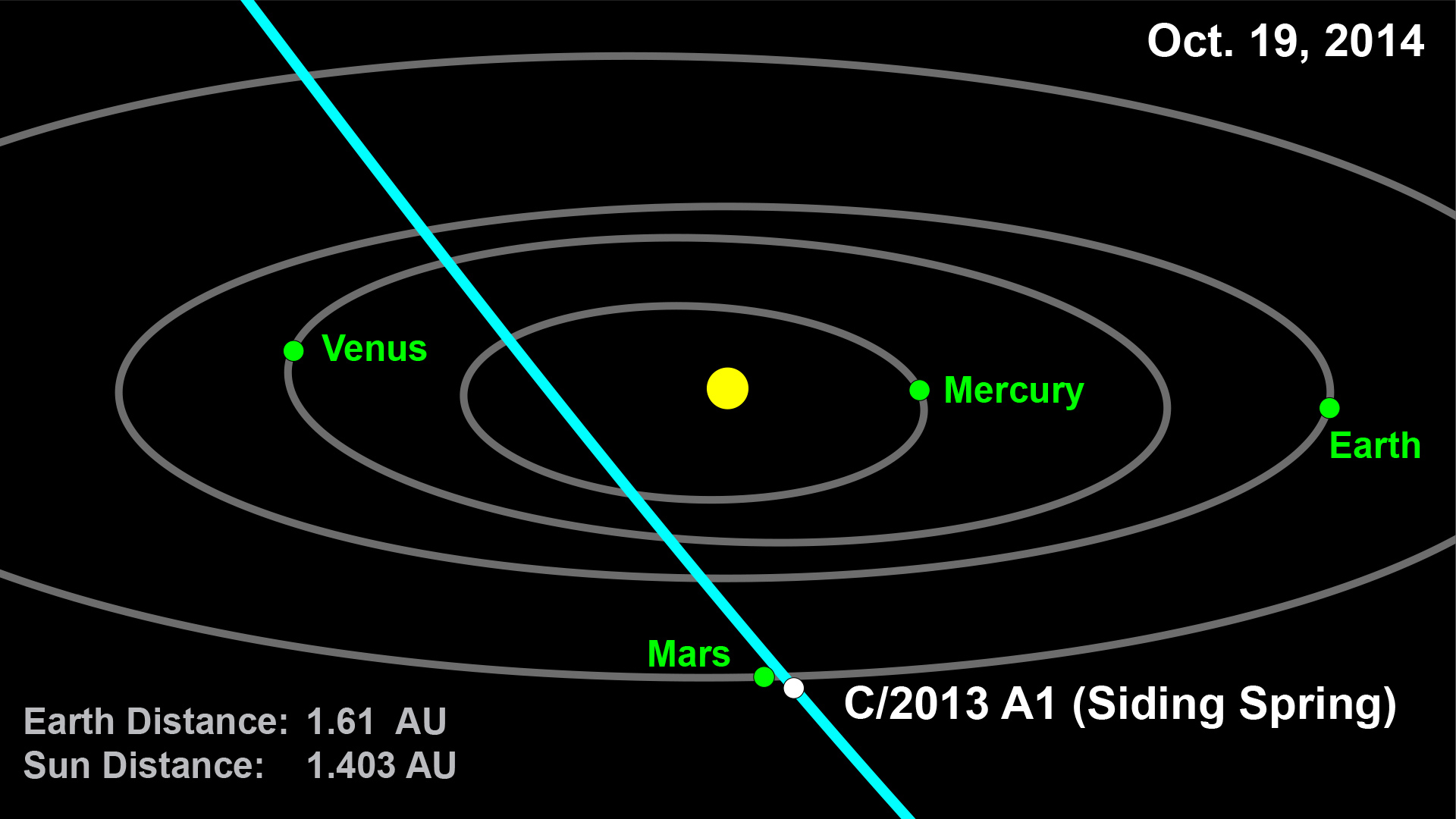
Curiosity and Opportunity will attempt to image the comet as they have the Martian moons Phobos and Deimos. They will also monitor the atmosphere for potential meteors in the wake of the dust trail.
Optical and ultraviolet measurements from NASA’s Swift science satellite in May 2014 determined that the icy nucleus of comet Siding Spring is about 2,300 feet (700 meters) across. It was also offgassing water as frozen material sublimates from the Sun’s heating effect at a rate of 13 gallons, or 49 liters, per second.
Other space-based probes have also imaged Siding Spring to prepare for the Oct. 19 flyby, including NASA’s Hubble Space Telescope and Neowise mission.
Comet C/2013 A1 Siding Spring was discovered by Robert H. McNaught on Jan. 3, 2013, using the .05-meter (20-inch) Uppsala Schmidt Telescope, at Siding Spring Observatory in New South Wales, Australia. It was 7.2 AU from the Sun and located in the constellation Lepus.
McNaught has discovered numerous comets and asteroids including Comet Mcnaught, or C/2006 P1, which was widely visible to the naked eye in the Southern Hemisphere during 2007 and was the brightest in four decades.
Stay tuned here for continuing updates.
Want to keep up-to-date with all things space? Be sure to “Like” AmericaSpace on Facebook and follow us on Twitter: @AmericaSpace
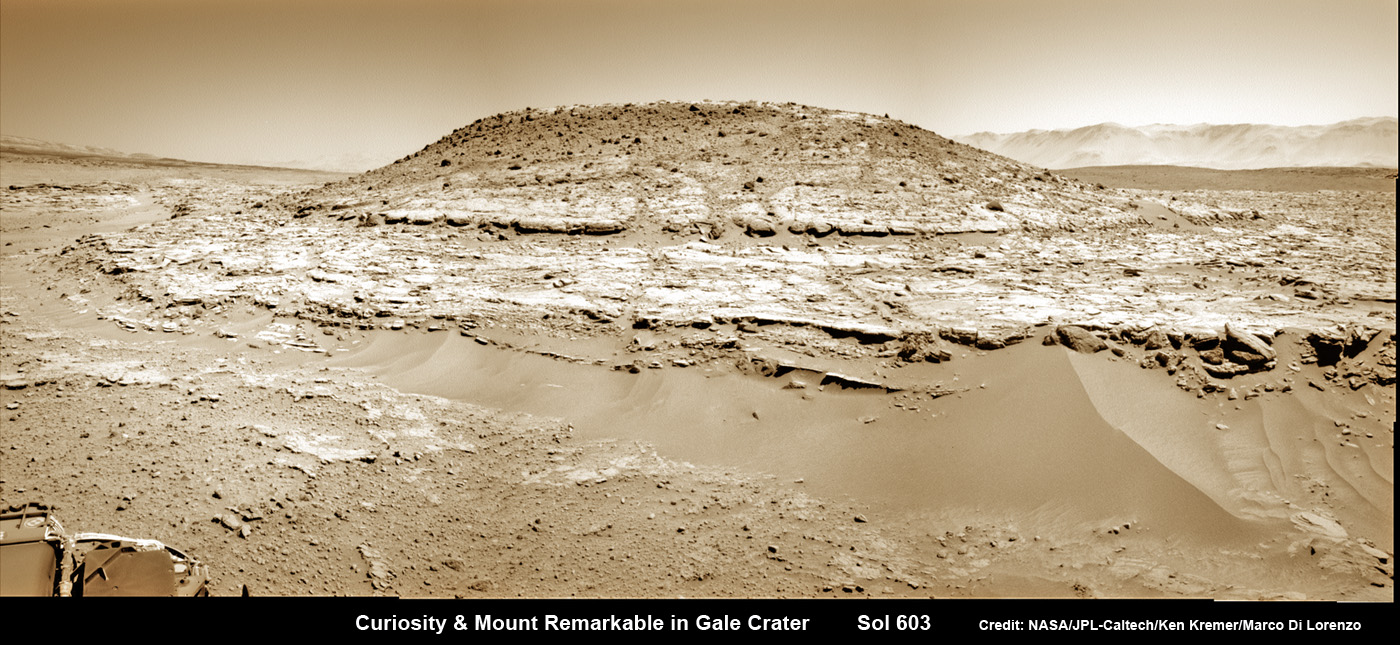
Curiosity will look to the Martian skies in October 2014 and attempt to image Comet Siding Spring!
Curiosity’s Panoramic view of Mount Remarkable at ‘The Kimberley Waypoint’ where rover conducted 3rd drilling campaign inside Gale Crater on Mars. The navcam raw images were taken on Sol 603, April 17, 2014, stitched and colorized. Credit: NASA/JPL-Caltech/Ken Kremer – kenkremer.com/Marco Di Lorenzo
Featured on APOD – Astronomy Picture of the Day on May 7, 2014




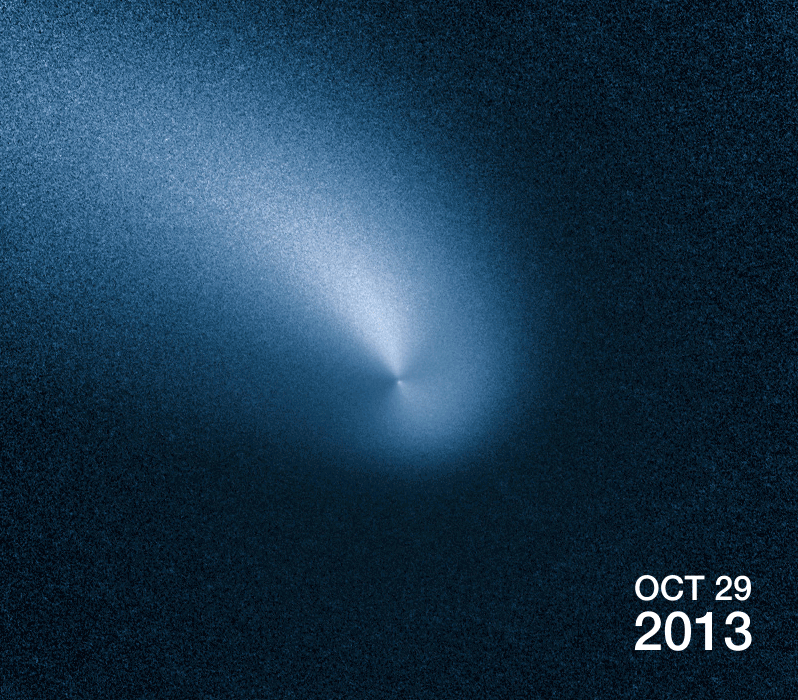
I hope this comment doesn’t contravene your posting rules, since I have added a url address.
The discoverer, Robert H. McNaught has another comet that was actually named after him, “Comet McNaught” which I shot vision of from a prosumer camera in a backyard in the middle of suburban Perth in Western Australia in 2012. It can be found at:
http://youtu.be/K-8LVaFtexQ
I am sure NASA, etc will get much better vision than what I achieved, of the new one.
Oooops the date of the video was 20/01/2007.